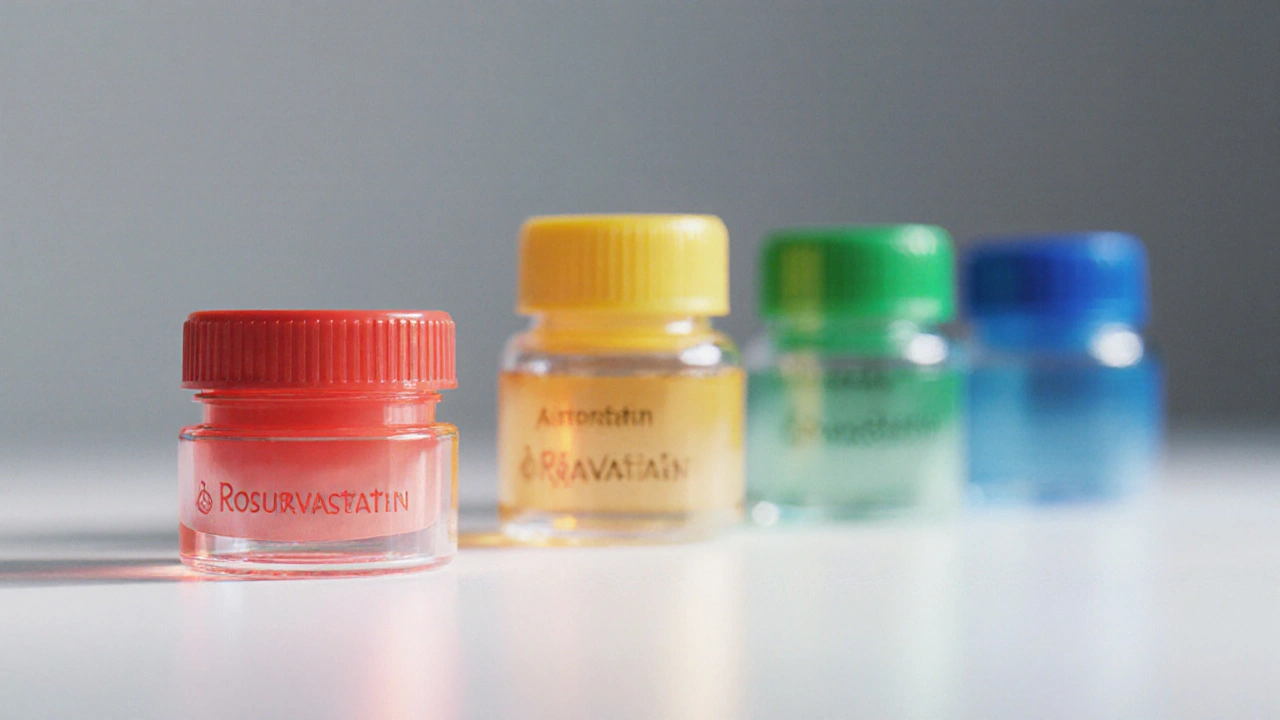Rosuvastatin vs Other Statins Comparison Tool
Recommended Statin:
Detailed Comparison Table:
| Statin | LDL Reduction | Starting Dose | Safety Notes | Avg. Monthly Cost |
|---|---|---|---|---|
| Rosuvastatin | 45-55% | 5-10 mg | Low muscle risk, modest liver impact, may raise blood sugar | $55-$70 |
| Atorvastatin | 35-45% | 10-20 mg | Higher muscle-pain risk at >40 mg, liver monitoring needed | $25-$40 |
| Simvastatin | 25-35% | 20-40 mg | Significant drug-interaction potential (CYP3A4), higher myopathy risk above 40 mg | $15-$30 |
| Pravastatin | 20-30% | 10-40 mg | Very low drug-interaction risk, gentle on liver enzymes | $20-$35 |
| Lovastatin | 20-30% | 20-80 mg | May cause gastrointestinal upset, moderate interaction risk | $12-$25 |
Key Takeaways
- Rosuvastatin is the most potent statin available, often needing a lower dose to achieve the same LDL reduction as older drugs.
- Atorvastatin offers a good balance of potency and cost, making it the most prescribed statin worldwide.
- Simvastatin is useful for mild‑to‑moderate cholesterol needs but carries higher muscle‑related risk at higher doses.
- Pravastatin and lovastatin are the gentlest on the liver and have the fewest drug interactions, ideal for patients on multiple meds.
- Choosing the right statin depends on LDL target, budget, existing health conditions, and potential drug‑drug interactions.
When it comes to lowering bad cholesterol, patients and doctors often ask, "Rosuvastatin compare to other options?" The short answer is: it’s the strongest statin on the market, but that strength comes with a higher price tag and a specific side‑effect profile. This guide breaks down the most common alternatives-atorvastatin, simvastatin, pravastatin, and lovastatin-so you can decide which fits your health goals, wallet, and lifestyle in 2025.
What to Look at When Comparing Statins
Statins belong to the same drug class, but they differ in four key areas that matter for everyday use:
- Potency and LDL‑C reduction - how much does the drug lower low‑density lipoprotein (LDL) cholesterol?
- Dosing flexibility - can you achieve the target with a low dose, or do you need higher doses that raise side‑effect risk?
- Safety profile - liver enzyme elevation, muscle pain (myopathy), and risk of diabetes.
- Cost & insurance coverage - out‑of‑pocket price and whether it’s on the PBS (Pharmaceutical Benefits Scheme) in Australia.
We’ll score each statin across these criteria in the table below, then dive deeper into the specifics.
| Statin | Typical LDL Reduction* | Starting Dose (mg) | Key Safety Notes | 2025 Avg. Cost (AU$ per month) |
|---|---|---|---|---|
| Rosuvastatin high‑potency statin | 45‑55% | 5‑10 | Low muscle risk, modest liver impact, may raise blood sugar | $55‑$70 |
| Atorvastatin widely used medium‑high potency statin | 35‑45% | 10‑20 | Higher muscle‑pain risk at >40mg, liver monitoring needed | $25‑$40 (generic) |
| Simvastatin moderate‑potency statin | 25‑35% | 20‑40 | Significant drug‑interaction potential (CYP3A4), higher myopathy risk above 40mg | $15‑$30 (generic) |
| Pravastatin mild‑potency, liver‑friendly statin | 20‑30% | 10‑40 | Very low drug‑interaction risk, gentle on liver enzymes | $20‑$35 (generic) |
| Lovastatin first‑generation statin | 20‑30% | 20‑80 | May cause gastrointestinal upset, moderate interaction risk | $12‑$25 (generic) |
Rosuvastatin in Detail
Rosuvastatin, sold under brand names like Crestor, was approved in 2003 and quickly became the go‑to choice for patients needing a big LDL drop. Its chemical structure gives it a long half‑life (about 19hours), allowing once‑daily dosing.
Efficacy: Clinical trials (e.g., the JUPITER study) showed a ~50% LDL reduction when starting at 10mg, translating to a 20‑30% drop in major cardiovascular events.
Typical Dosage: Most physicians begin with 5mg for moderate risk and jump to 10mg if LDL goals aren’t met. The maximum approved dose is 40mg, but few patients need that much.
Safety Profile:
- Muscle pain occurs in <5% of users, lower than many older statins.
- Liver enzymes (ALT/AST) may rise modestly; routine labs every 3‑6months are recommended.
- Small increase in new‑onset diabetes risk, especially in patients already pre‑diabetic.
- Rarely, severe rhabdomyolysis-monitor if you’re on fibrates or high‑dose niacin.
Drug Interactions: Because rosuvastatin is metabolized mainly by CYP2C9 (not CYP3A4), it avoids many interaction pitfalls. Still, watch out for cyclosporine, certain HIV protease inhibitors, and strong CYP2C9 inhibitors.
Cost: In Australia, the PBS covers rosuvastatin for high‑risk patients, but many still pay a co‑payment of $30‑$45 per month. Generic versions have started appearing in 2024, bringing the price down to around $55.
Atorvastatin - The Workhorse
Atorvastatin a medium‑high potency statin is the most prescribed lipid‑lowering drug globally. It hit the market in 1996 and remains a solid choice for both primary and secondary prevention.
Efficacy: A 20mg dose lowers LDL by ~35%. Dose‑response is fairly linear up to 80mg, which can achieve a 45‑% reduction.
Safety: Myopathy risk rises noticeably above 40mg, and atorvastatin can mildly raise liver enzymes. It also has a small impact on blood sugar.
Interactions: It’s metabolized by CYP3A4, so strong inhibitors (e.g., clarithromycin, itraconazole) can boost levels and muscle side effects. Grapefruit juice should be limited.
Cost: Widely generic, it’s the cheapest high‑potency option-often under $30 per month.
Simvastatin - Low‑Cost, High‑Interaction Risk
Simvastatin an older moderate‑potency statin entered the market in 1991. It’s still used, especially when budget constraints dominate.
Efficacy: At 20mg, LDL drops 25‑30%. Above 40mg, the marginal benefit tapers, but side‑effect risk climbs.
Key Concerns:
- Strong CYP3A4 metabolism means many drug‑drug interactions (e.g., amiodarone, certain antibiotics).
- FDA recommends a maximum of 40mg unless a patient is on a low‑dose, due to myopathy risk.
Cost: One of the cheapest statins-often $10‑$20 per month for the 20mg tablet.
Pravastatin - Gentle on the Liver
Pravastatin a mild‑potency, liver‑friendly statin is a good fallback for patients with a history of liver sensitivity or multiple medications.
Efficacy: Typical LDL reductions of 20‑30% at 10‑20mg. Not enough for high‑risk patients needing aggressive targets.
Safety: Very low incidence of muscle pain and minimal effect on liver enzymes. Drug‑interaction profile is among the cleanest of the statin class.
Cost: Generic price hovers around $20‑$30 per month; widely covered by PBS.
Lovastatin - The Pioneer
Lovastatin the first statin approved for clinical use dates back to 1987. It’s less potent but still useful for mild hypercholesterolemia.
Efficacy: LDL reduction of about 20‑25% at 20‑40mg. Requires twice‑daily dosing with meals.
Safety: Slightly higher GI upset compared with newer statins, moderate interaction risk via CYP3A4.
Cost: Cheapest option on the market, often under $12 per month.

How to Choose the Right Statin for You
There’s no one‑size‑fits‑all answer. Below is a quick decision guide based on the four criteria we discussed.
- Need a big LDL drop (≥45%): Rosuvastatin or high‑dose atorvastatin.
- Budget is tight: Atorvastatin generic or simvastatin (if no major drug interactions).
- Take many other meds: Pravastatin or rosuvastatin (less CYP3A4 involvement).
- History of muscle pain: Start low with rosuvastatin or pravastatin; avoid high‑dose simvastatin.
- Concern about diabetes risk: Prefer rosuvastatin at the lowest effective dose or pravastatin.
Always discuss with your GP or cardiologist. They’ll run a baseline lipid panel, check liver enzymes, and consider your overall cardiovascular risk (e.g., age, smoking, blood pressure).
Practical Checklist Before Starting a Statin
- Confirm your latest fasting lipid profile (LDL, HDL, triglycerides).
- Ask about any current prescriptions, over‑the‑counter meds, or herbal supplements.
- Schedule baseline liver function tests (ALT, AST) and a creatine kinase (CK) check if you’ve had muscle issues before.
- Set a realistic LDL target based on your risk category (e.g., < 2.0mmol/L for high risk).
- Plan a follow‑up lipid test in 6‑12 weeks after starting or adjusting dose.
- Keep a symptom diary for muscle aches, fatigue, or unusual weakness.
Frequently Asked Questions
Can I switch from rosuvastatin to another statin if I experience side effects?
Yes. Most doctors will start you on a lower dose or try a gentler statin like pravastatin. Switching is usually done after a 2‑week washout period to avoid overlapping drug levels.
Do statins, including rosuvastatin, increase my risk of diabetes?
All statins carry a modest increase (about 10‑12%) in new‑onset type2 diabetes, especially at high doses. The cardiovascular benefits still outweigh this risk for most patients.
Is it safe to take rosuvastatin with a grapefruit diet?
Rosuvastatin is not significantly metabolized by CYP3A4, so grapefruit has little effect. However, always check with your pharmacist if you’re on other meds that do interact with grapefruit.
How long does it take to see a cholesterol drop after starting rosuvastatin?
Most patients see a 15‑20% reduction within 2weeks, with the full effect (up to 50%) reached by 4‑6weeks.
What monitoring is needed while on a statin?
Baseline liver enzymes and CK, then repeat at 3‑6months. If you develop muscle pain, a CK test is recommended immediately.
Next Steps
If you’re ready to start or switch a statin, follow this quick plan:
- Book an appointment with your GP and bring a recent lipid panel.
- Discuss your cardiovascular risk and any concerns about side effects.
- Agree on a starting dose (often rosuvastatin 5mg or atorvastatin 10mg).
- Schedule lab tests for liver enzymes and CK in the next 6‑8 weeks.
- Track any new symptoms and report them promptly.
With the right statin and regular monitoring, you’ll be on a clear path to lower LDL and a healthier heart.






April Conley
October 7, 2025 AT 17:13Rosuvastatin packs the most LDL drop per mg, but the price tag isn’t cheap.
Sophie Rabey
October 11, 2025 AT 02:27Ah, the classic “you get what you pay for” narrative-while ignoring the pharmacokinetic nuances like CYP450 interactions that make Atorvastatin a “budget‑friendly” workhorse.
Bruce Heintz
October 14, 2025 AT 11:41If you’re new to statins, start low and monitor your labs; most patients tolerate 5 mg of rosuvastatin well 😊. Adjust based on your LDL targets and any muscle symptoms.
richard king
October 17, 2025 AT 20:54Behold! The mighty rosuvastatin, the silver bullet of cholesterol wars, yet even titans can falter under the weight of hidden side‑effects.
Dalton Hackett
October 21, 2025 AT 06:08When comparing statins, several variables come into play that can dramatically alter the therapeutic decision‑making process.
First, the magnitude of LDL‑C reduction is a primary efficacy endpoint, and rosuvastatin consistently achieves 45‑55% reduction at low doses, outpacing many of its peers.
Second, dose flexibility matters because higher doses of some agents, such as simvastatin above 40 mg, carry an increased risk of myopathy.
Third, safety considerations span hepatic enzyme elevation, muscle toxicity, and the emerging data linking high‑potency statins to modest increases in blood glucose.
Fourth, economic factors cannot be ignored; while rosuvastatin’s monthly cost ranges between $55‑$70 in Australia, generic atorvastatin can be obtained for as little as $25‑$40.
Fifth, patient‑specific factors such as concomitant medications and comorbidities dictate the choice-pravadastatin’s low interaction profile benefits polypharmacy patients.
Sixth, adherence is influenced by dosing frequency; rosuvastatin’s long half‑life permits once‑daily dosing, aiding compliance.
Seventh, insurance coverage, especially PBS listings, may limit options for some patients, making generic options more attractive.
Eighth, the clinician must weigh the potential for adverse events against the cardiovascular risk reduction demonstrated in large trials like JUPITER.
Ninth, in patients with a history of statin‑induced diabetes, agents with lower glycemic impact, such as pravastatin, might be preferred.
Tenth, liver function monitoring remains essential for all statins, but the degree of elevation varies.
Eleventh, drug‑drug interactions, particularly via CYP3A4, are significant with simvastatin and lovastatin, requiring dose adjustments or alternative agents.
Twelfth, patient education about potential muscle symptoms can prompt early detection and management.
Thirteenth, the goal LDL target set by guidelines informs whether a high‑potency statin is warranted.
Fourteenth, genetic factors, like SLCO1B1 polymorphisms, affect statin metabolism and risk of myopathy.
Fifteenth, shared decision‑making empowers patients to choose a regimen aligning with their values and financial capacity.
William Lawrence
October 24, 2025 AT 15:22Sure, because cheap pills always work better.
Grace Shaw
October 28, 2025 AT 00:36When considering a statin regimen, it is incumbent upon the prescribing clinician to evaluate both efficacy and safety profiles, thereby ensuring optimal patient outcomes.
Sean Powell
October 31, 2025 AT 09:50We all have different budgets so feel free to pick the one that fits your wallet and health goals.
Henry Clay
November 3, 2025 AT 19:04Let’s ignore the fact that higher potency means higher risk of diabetes and call it a win.
Isha Khullar
November 7, 2025 AT 04:17In the grand theatre of medicine, rosuvastatin takes centre stage, yet the understudies often steal the show.
Lila Tyas
November 10, 2025 AT 13:31Hey folks! If you’re juggling insurance coverage, rosuvastatin might be pricey but the LDL drop can be a game‑changer. For many, the savings from fewer heart events outweigh the drug cost.
Mark Szwarc
November 13, 2025 AT 22:45Remember to check liver enzymes before and after initiating any statin; this is especially important with higher doses of rosuvastatin.
BLAKE LUND
November 17, 2025 AT 07:59Some people just love the idea of a “one‑size‑fits‑all” pill, but the reality is a bit more nuanced.
Veronica Rodriguez
November 20, 2025 AT 17:13Don’t forget to discuss with your doctor any existing meds to avoid nasty interactions 😊.